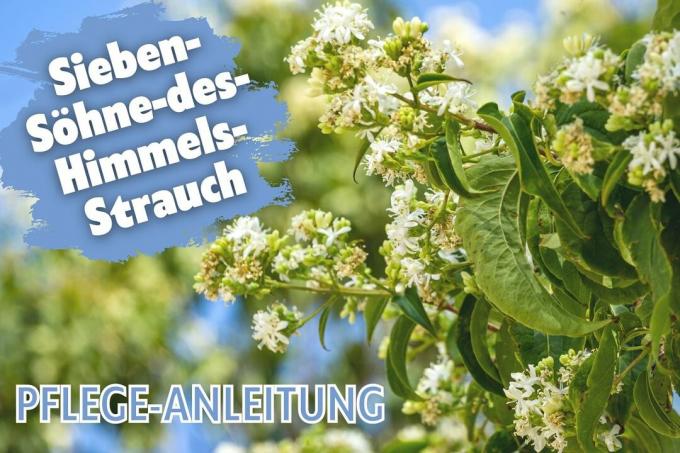
table of contents
- Location
- plants
- Care instructions
- Watering and fertilizing
- Cut
- Overwinter
- Transplant older specimens
- Bucket keeping
- Multiplication
- Diseases and pests
- frequently asked Questions
Profile and care information open +conclude -
- Flower color
- White
- Location
- Partial shade, sunny
- Heyday
- August September
- Growth habit
- upright
- height
- up to 400 cm high
- Soil type
- sandy, loamy
- Soil moisture
- moderately dry, fresh
- PH value
- weakly alkaline, weakly acidic
- Limescale tolerance
- Calcium tolerant
- humus
- rich in humus
- Poisonous
- Yes
- Plant families
- Honeysuckle Family, Caprifoliaceae
- Plant species
- Flowering shrubs, ornamental shrubs
- Garden style
- Flower garden, natural garden, ornamental garden
The Seven Sons of Heaven (Heptacodium miconioides) impresses with its pretty and wonderfully fragrant flowers, a long flowering period and decorative fruit decorations. Even the bark of this easy-care ornamental wood is worth seeing.
Location
In its natural habitat, the Sieben-Söhne shrub grows in steppes and dry forest areas in sunny to light-shaded locations. Accordingly, it also needs a warm and sunny place in the garden, but also thrives in partial shade. It is heat and drought tolerant, as long as it is not too dry for too long. He is also very tolerant of environmental influences.
The Sieben-Söhne-des-Himmels-Shrub thrives in any normal garden soil that is permeable, rich in nutrients and humus and not too moist. Sandy to loamy, moderately dry to fresh and weakly alkaline to weakly acidic substrates are ideal.
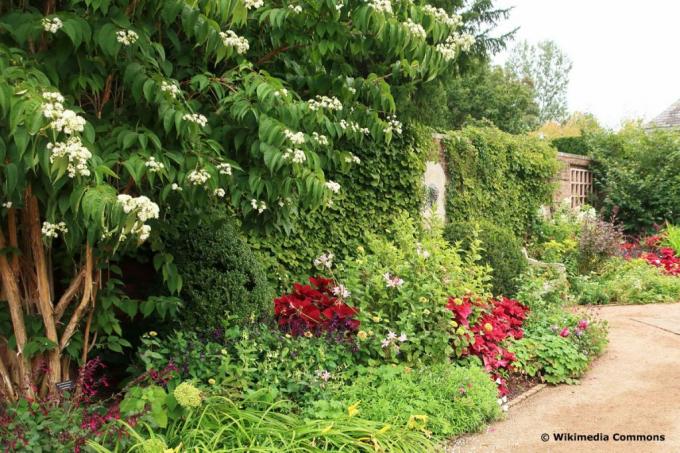
Tip: This shrub also copes well with root pressure from other plants.
plants
Both spring and autumn are suitable for planting, but spring is preferred. This is especially true for plants with root balls. Container plants can be planted most of the year, with the exception of periods of intense summer heat or frozen ground. Before planting, it is advisable to water the root ball thoroughly.
- Dig a sufficiently large planting pit
- if possible not too deep
- subsequent sagging would be the result
- Tree could then stand too low
- Lay the sub-floor separately from the upper floor
- Take the plant out of the pot
- Loosen the balls of the feet with your hands
- Fill the subsoil into the planting pit
- Insert the bush in the middle
- Check planting depth, fill with topsoil
- Create the pouring edge, about 15-30 cm high
- then rinse thoroughly
If necessary, it makes sense to have an anchoring or To attach support. This ensures that the roots can develop undisturbed and that the particularly sensitive, fine roots are not torn off in stronger winds.
Tip: Compacted or poor quality soil should not be used to fill the planting hole. HeavinessClay soils are best mixed with sand and / or humus.
Care instructions
In terms of care, the Sieben-Söhne-des-Himmels shrub is rather undemanding.
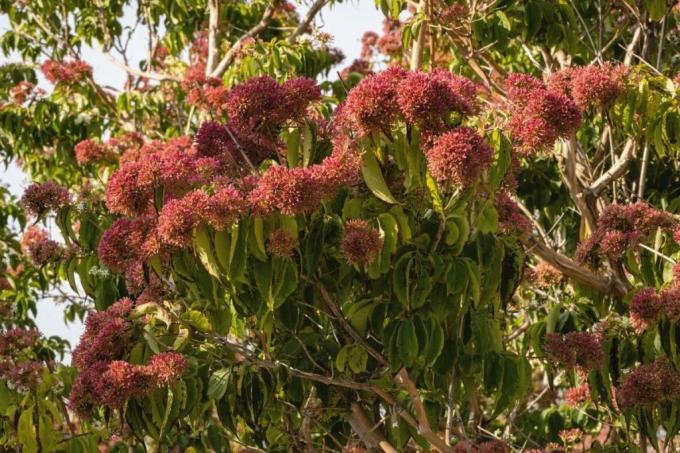
Watering and fertilizing
It only needs to be watered in prolonged heat and drought. Newly planted specimens are an exception; they should be watered regularly for the first five years, depending on the weather. An approx. A five-centimeter thick layer of mulch on the root area ensures that the soil does not dry out so quickly.
The seven bell bush is also extremely frugal when it comes to fertilizing. As a rule, it is sufficient to provide it with a liquid long-term fertilizer in the spring. This continuously releases its nutrients to the plant so that it is well supplied over a long period of time.
Cut
The Sieben-Söhne-des-Himmels-Shrub does not generally have to be pruned, but it still tolerates a cut well. By nature, it grows very irregularly and bushy in its youth, which is also appreciated by many plant lovers. In old age it can happen that it becomes a little bald from below and develops more into a small tree.
Removing dead wood or annoying branches in spring is no problem. If necessary, the Sieben-Söhne-des-Himmels-Shrub can also be cut more deeply to a height of about 20 cm. Then it usually sprouts vigorously and with multiple shoots. You can even cut into the old wood here. Even old eyes drive out again.
Overwinter
Heptacodium miconioides is very hardy in winter. Nevertheless, it is advisable to protect specimens planted in autumn from severe frosts in the first two winters. To do this, cover the root area with bark mulch or fir branches. No more protection is required. As soon as the shrub is well rooted, winter protection can usually be dispensed with.
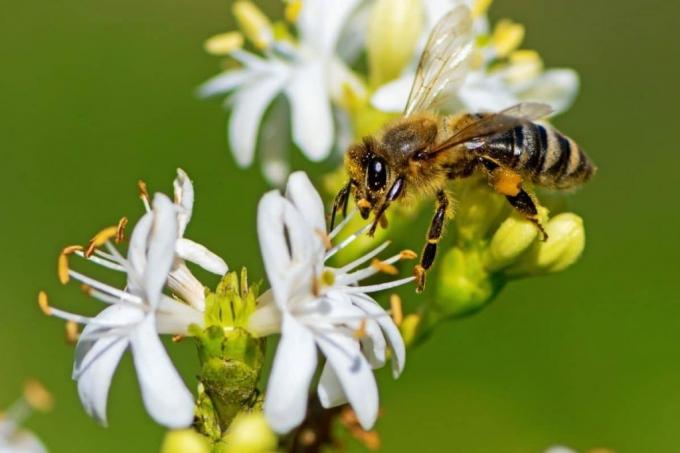
Transplant older specimens
Of course, it is best to plant this shrub in a place where it can stand permanently. Spontaneous repotting is not recommended as it could die. It is best to prepare it in the first year and only transplant it in the second year.
- dig a narrow trench around the plant in the first year
- at a distance of 50 cm from the base of the bush
- Then fill the trench with loose excavation
- then formation of new fine roots near the trunk
- in the second year lift the root ball out of the earth
- in a radius about 10 cm larger
When digging the trench, the outer roots are cut all around, but those that go deep can still provide the plant with sufficient water and nutrients. In both the first and second year it is advisable to prune the shrub heavily in order to balance the reduced root mass and the leaf mass.
Bucket keeping
This plant naturally feels most comfortable in the garden, preferably in a solitary position. However, keeping them in the bucket is basically possible. However, there are a few things to keep in mind.
- Bucket shouldn't be too small
- Put a drainage made of gravel on the bottom of the bucket
- place a fleece on top
- Substrate made of 80% white peat and 20% gravel, expanded clay or similar
- Addition of aggregates possible
- how Horn shavings, Stone flour or compost
- pay attention to the nitrogen content
- The substrate should have a pH between 5.5 and 6.0
- lime up if necessary
- use a complete nutrient fertilizer for fertilization
- about two grams of fertilizer per liter of substrate

Plants in the tub must be well protected in winter. Therefore, as soon as the temperatures drop permanently below minus eight degrees, they are moved to a protected winter quarter. Furthermore, potted plants can be cut back annually, which makes the plants more stable and allows them to grow back bushier.
Multiplication
sowing
When the seeds in the egg-shaped nut fruits are ripe, they can be sown. This is usually the case between October and November. They are found in the bright red fruits that are formed after flowering. You need a growing vessel, normal growing soil and translucent foil as a cover.
- Fill the growing vessel with growing medium
- Spread seeds on it
- Press lightly and moisten the substrate
- Stretch film over it for an optimal climate
- Remove the ventilation film every day
- Place the seed container in a bright, not too warm place
- do not expose to direct sun
- Get the seedlings used to the sun in spring or toughen up
- only plant out completely in the second spring
Tip: Propagation by sowing does not result in plants identical to the mother plant. The genetic material or Genetic material is re-mixed, which means that the characteristics of the offspring can vary to a greater or lesser extent.
Cuttings
In contrast to sowing, propagating cuttings produces an identical image of the mother plant. The offspring have exactly the same genetic make-up. Even the flowering maturity of the mother plant is carried over to it. The best time to cut cuttings from the seven bell bush is in summer. They should already be slightly lignified, not too soft and about 15-20 cm long.
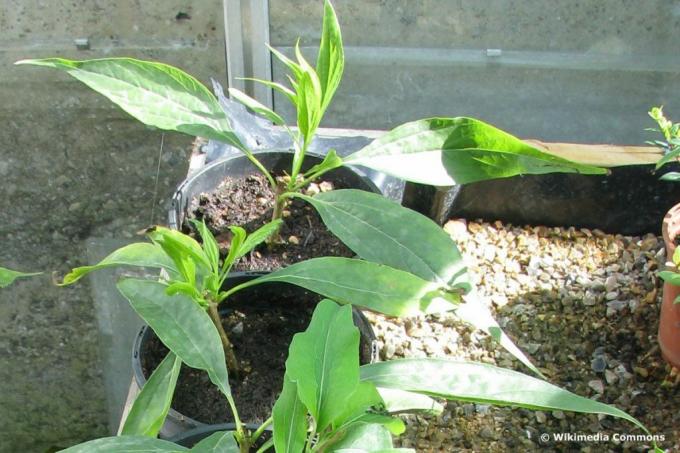
- Cut just above or below a bud
- remove the lower leaves
- Put the cuttings in potting soil
- two eyes should be covered with earth
- Press the substrate lightly and moisten it
- cover with transparent foil
- remove foil after rooting
- Prick out the seedlings if necessary
- keep the winter bright and cool
- plant in the garden in spring
- Care like adult plants
Tip: The part of the cutting that is in the ground should absolutely be leafless, otherwise there is a risk of rot and the cutting of the cutting.
Diseases and pests
The Seven Sons of Heaven shrub is very robust against diseases. Occasionally there may be an infestation with Aphids come. But this is mostly limited to the young shoot tips. The Sieben-Söhne-des-Himmels-Shrub usually copes with this quite well without taking any major damage. To combat it, it is usually sufficient to thoroughly shower the plant in question with water.
frequently asked Questions
No, Heptacodium miconioides is deciduous, but does not lose its leaves until relatively late. On the other hand, it impresses in the leafless time with its yellow-brown to brown, flaking bark.
If the Sieben-Söhne shrub is permanently in the tub, it should be repotted every 2-3 years or as soon as the tub is well rooted.
In our latitudes, including the Seven Sons of Heaven shrub, as a rule, it is too cold for that.


